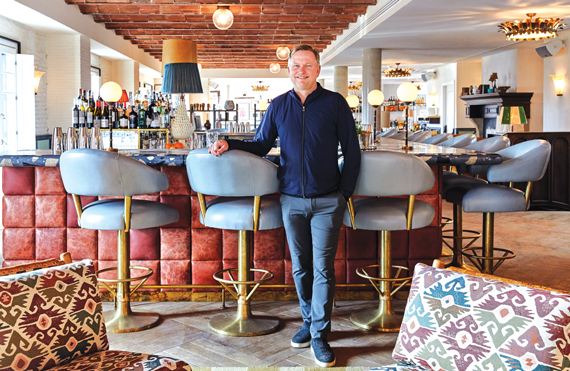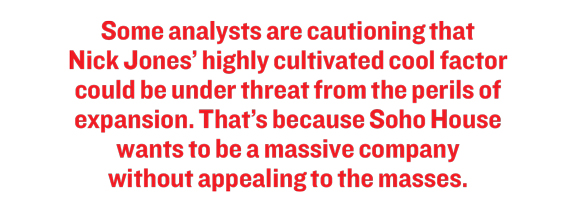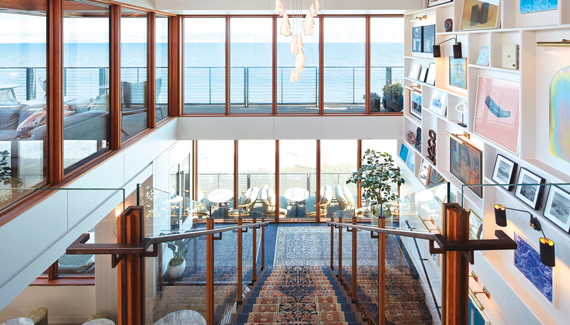Trending
Soho House’s soul-searching
The members-only club is betting</br> that the global-property-buying</br> spree that’s hurting its books now will pay dividends later

It was 1996, shortly after he’d sold his shares in Virgin Entertainment, when Robert Devereux sat down to lunch with an old friend at 192, a famed celebrity haunt in London’s Notting Hill.
“We were expostulating about the state of English country house hotels — how old-fashioned they were — when he said I should meet Nick Jones,” Devereux remembered. “My friend said Nick Jones thought exactly the same way and was about to buy a property in Somerset.”
Devereux — who has four children with his ex-wife, Vanessa, Virgin founder Richard Branson’s sister — eventually became one of the early investors and the chairman of Soho House, the trendy members-only club that Jones founded in 1995 in a townhouse in the London neighborhood with the same name.
It was telling that the two bonded over their like of old-fashioned country-house hotels. Soho House was the modern-day answer to the stodgy literary gentlemen’s clubs such as Groucho’s once so prevalent in London.
The Georgian-style Somerset property that Devereux’s friend was referring to was located on 18 acres in southwest England. In addition to its 33 bedrooms, the site — which is known as Babington House and was Soho House’s second location —includes a private lodge, a 45-seat cinema, a children’s space, a log room, a dining room in an orangery, a bar, a library, a tennis court and a cricket field, among other amenities.
Jones, the son of an insurance broker from Cobham, Surrey — a village 17 miles from London — was the sultan of Soho House cool, rubbing shoulders with celebrities such as Hollywood honcho Harvey Weinstein, actress Julia Roberts and hotelier André Balazs, among countless others. He was also the brand’s curator, banning suits, overseeing interior design, rejecting unworthy members and nitpicking the menu.
Over the next decade or so, Jones and his investors opened more clubs and a slew of restaurants and hotels, with plans for additional venues in the works.
But it wasn’t until Jones teamed up with his current business partners — fashion and hospitality mogul Richard Caring, who came on board in 2008, and billionaire investor Ron Burkle, who invested in 2012 — that Soho House expansion went into overdrive.
 Today, Soho House has 18 clubs in locations around the world, including New York, Los Angeles, Miami, Toronto, Berlin, Istanbul — and Barcelona, which just opened last fall. It also has 16 restaurant brands, 11 hotels, 18 spas, one shared office space, two cinemas and three beauty products lines. And it’s recently expanded into home goods and furnishings through its online subsidiary, Soho Home.
Today, Soho House has 18 clubs in locations around the world, including New York, Los Angeles, Miami, Toronto, Berlin, Istanbul — and Barcelona, which just opened last fall. It also has 16 restaurant brands, 11 hotels, 18 spas, one shared office space, two cinemas and three beauty products lines. And it’s recently expanded into home goods and furnishings through its online subsidiary, Soho Home.
Now, rather than leasing properties as it has in the past, it has ramped up its property buying in a shift that many are viewing as an opportunistic real estate play.
But the expenses associated with the aggressive expansion and buying binge have put pressure on the company’s cash flow, leading credit ratings agencies such as Moody’s and Standard & Poor’s — which produce reports on Soho House because it’s raised money on the U.K. bond market — to downgrade its ratings last year.
As a result, some analysts are now cautioning that Jones’ highly cultivated brand could be under threat. In short, Soho House wants to be a massive company without appealing to the masses. Indeed, its success hinges on its ability to maintain its ultra-exclusive image while still adding thousands of new members and generating enough revenue to keep up with its expansion.
Bringing in Burkle
Soho House’s business model is multi-pronged.
At its private social clubs, it charges membership fees that currently range from about $2,000 to $2,800 a year. But those fees only account for roughly 21 percent of its revenues. The company rakes in another 53 percent of its revenues from food and drink sales, a company spokesperson said.
But for Burkle [TRDataCustom], the financial upside on his Soho House investment does not lie in the business of Soho House itself. Instead, it’s derived from the real estate the company owns — or could snap up. And given how much of the company he owns (he has a 60.1 percent stake) and the fact that he financially rescued the company, he has the clout to make real estate a priority.

Ron Burkle
The holding company for Soho House’s myriad network of LLCs — which goes by the name Soho House & Co. Limited — was reportedly saddled with more than $230 million in debt when Burkle stepped in as its financial white knight in 2012. Several reports valued the deal at £250 million, or about $317 million at that time, though Burkle has denied that figure.
(In addition to Burkle’s 60.1 percent stake, Caring owns 31 percent of the company and Jones holds 8.3 percent.)
At the time of his purchase, Burkle was perhaps best known for his investments in supermarkets, including Whole Foods, as well as high-profile companies such as Barnes & Noble. He is also part owner of the NHL’s Pittsburgh Penguins, and was a major Democratic donor who tapped former President Bill Clinton as a consultant for his private equity firm, Yucaipa Companies. Sources said Burkle saw the benefit that Soho House was creating for its landlords by making up-and-coming areas instantaneously trendier, and he wanted a piece of the action.
Others said Burkle, who has a reputation as a jet-setting playboy, simply liked the sexy nature of investing in the celebrity-friendly club.
“I think his social life affects people’s perception of him — it’s, like, some people say, ‘If you’re out chasing women all night, how could you be a good businessman?’” real estate mogul Sam Zell told the New Yorker in 2012, shortly after Burkle invested in Soho House.
Before Burkle and Caring stepped in, Soho House was growing gradually, renovating its leased spaces as quirky, historic social havens rather than buying properties.
“From my point of view, return on capital invested in the business is infinitely better invested than with property, and we had limited capital, so we had a choice,” explained Devereux, who was bought out, along with 27 other investors, by Caring in 2008.
“We had a policy of owning no properties. It was a very deliberate financial strategy when we started,” Devereux told TRD. “It’s a very different kind of company now — just the sheer scale of it.”
Caring’s investment began changing the game for Soho House, allowing it to pick up its first U.S. property, a $39 million site in Miami, which it partially bought in 2008 and then bought outright in 2014.

Richard Caring
But Burkle shook things up even more with his own deep pockets. When he came on board, he also threw down $67 million to buy the office portion of 29 Ninth Avenue, which Soho House was leasing in the Meatpacking District. The deal secured the club’s future at the site — and gave it lease terms that could not be beat.
And in L.A., Soho House owns an undisclosed stake in the building, where it will operate in Downtown’s Arts District.
The company also recently bought its just-opened Barcelona site and its new New York location at 139 Ludlow Street on the Lower East Side.
Burkle has already reaped the financial rewards of his Soho House investments.
Last year, he unloaded his stake in the Ninth Avenue building, but not without locking in the generous lease terms he had given Soho House earlier.
In an email to TRD, Jones explained Soho House’s recent purchases.
“There is no question that our presence within a new neighborhood is a catalyst for real-estate appreciation,” he wrote. “We’re taking a more disciplined approach [to real estate]. It will allow us to benefit from the rise in real estate values that usually happens when we enter into new neighborhoods, which will also allow us to continue to grow.”
He added: “The opportunity has always been there, but we now have the capital and expertise to grow in this way.”
In some cases, however, Soho House is still leasing. In New York, it leases its Ninth Avenue space and will be doing the same at its forthcoming Cecconi’s restaurant at the Empire Stores in Dumbo. And in Malibu, Calif., its space is owned by Oracle software mogul Larry Ellison.
But while real estate plays may make sense in the long run, Soho House is taking a financial bullet for using that strategy now.
In March, Moody’s justified it’s “negative” investment label by citing the company’s lower-than-anticipated profits, weak liquidity, high leverage (which the rating agency pegged at 10 times annual earnings) and negative free cash flow — combined with its plans for global domination.
“Given the high amount of debt service and the ambitious expansion plan, we expect the company to remain free cash flow negative in the next two years and to continue to rely strongly on external sources of funding,” a Moody’s analysis concluded.

Soho House’s Little Beach House in Malibu
In 2015, the most recent year for which numbers were available, Soho House had revenues of £283.8 million (or about $358 million at the time) and EBITDA (earnings before interest, taxes, depreciation and amortization) of $61 million, according to Moody’s. But the company’s negative cash flow hit nearly $94 million, and it posted an operating loss of about $14 million in the year ending last January.
That red ink is expected to continue, at least according to Moody’s, which anticipates Soho House’s expenditures for 2016 and 2017 to be at least $49 million.
And Burkle, Caring and Jones have doled out their own cash for the firm in the past.
The owners reportedly ponied up about $50 million last year to cover expansion costs and have attempted other forms of raising cash, including upping its revolving credit facility to about $38 million, from roughly $6 million.
In 2014, for instance, they attempted (but failed) to tap the British bond markets for £200 million (or more than $300 million) to replace an existing $184 million bond, which had a super-high interest rate of more than 9 percent, according to news reports. When investors didn’t bite, the company blamed poor market conditions, but investors reportedly pointed to the firm’s earnings-to-debt ratio. The company is still seeking to refinance the bond before it matures in 2018.
For his part, Jones insisted that the company is on solid financial footing.
“Any business growing at this rate consumes a great amount of cash, but we have an incredibly talented team behind us to strategize this,” he said.
Cast of characters
When Devereux was at the helm of the company alongside Jones, he was just one of nearly 30 limited partners.
With so many investors, decision-making was a painstaking, committee-laden process, which stymied Jones’ growth aspirations. When Jones asked his co-investors to step aside to make way for Caring, they complied, albeit begrudgingly.
“We didn’t want to get out; we had done extremely well. But it was Nick’s business and he wanted the deal,” said Devereux, who described Jones, as a “peripatetic genius.”
 Although Burkle didn’t technically invest in the company until 2012, his relationship with Soho House dates back to 2006, when he first expressed interest in buying the club’s Ninth Avenue building. At the time, Burkle was searching for a New York penthouse and envisioned turning the top two floors of the building into a sprawling private residence and using the rest of the property for his company, according to a 2012 commission-related lawsuit that broker Nathaniel Christian filed against the billionaire and his firm.
Although Burkle didn’t technically invest in the company until 2012, his relationship with Soho House dates back to 2006, when he first expressed interest in buying the club’s Ninth Avenue building. At the time, Burkle was searching for a New York penthouse and envisioned turning the top two floors of the building into a sprawling private residence and using the rest of the property for his company, according to a 2012 commission-related lawsuit that broker Nathaniel Christian filed against the billionaire and his firm.
In that scenario, he would have needed to move Soho House out of the building and into another property on Greene Street in Soho. When he and Jones met in London to discuss the move, Jones instead urged Burkle to put his money into the company.
Burkle — whose spokesperson disputed Christian’s characterization of events —seemed genuinely excited by the prospect and even dangled the idea of helping Soho House launch in L.A., his hometown. He owned a site at 9130 Sunset Boulevard in West Hollywood that could be transformed into a Soho House site.
Following the meeting, the pair traded emails and drafted a plan to build a 125,000-square-foot property with a 68-room hotel, a private members club, a bowling alley, a cinema and a restaurant, according to internal company documents obtained by TRD. They even commissioned a model of the $90 million project.
Projections included in the documents reviewed by TRD show that the pair expected to generate $55 million a few years into operations at the West Hollywood location, a goal that would have required far more members than typical. A spokesperson for Soho House disputed those figures.
In exchange for Burkle bankrolling the company, Soho House would have moved out of the Meatpacking District building, paving the way for Burkle to create his dream apartment.
But the whole plan came to a screeching halt when Burkle found another home, a $17 million five-bedroom penthouse at the former Sky Studios building at 740 Broadway, sources said.
Jones, however, was still determined to jump-start his company’s growth and, in 2008, brought Caring into the fray. The British entrepreneur bought the 80 percent stake in the company owned by Jones’ 28 co-investors for $154 million. Five year later, Burkle nabbed 60 percent, reducing both Caring and Jones’ stakes to where they stand today.
Despite his silent-partner status, Caring has played a key role in the company. A restaurateur and fashion magnate with a carefully coiffed salt-and-pepper mane, a perpetual tan and a Colgate smile, he owns iconic clubs and nightlife venues such as the Ivy and Annabel’s in London and counts Topshop Chairman Philip Green as a close friend. Images of the two men flanking Bill Clinton, with all three clad in tailored 18th-century Russian garb at a children’s charity ball in St. Petersburg, abound online.
Caring, a contemporary art collector whose fortune is reportedly valued at more than $1 billion, in 2008 forked over nearly $15 million for an aardvark-in-formaldehyde by artist Damien Hirst, who was also one of Soho House’s original members.
While Caring and Burkle’s cash has been a boon to Soho House, speculation is rife that the well may begin to dry up soon.
For one thing, Caring is the midst of a high-profile divorce that British tabloids have reported could set him back more than half a billion dollars. In addition, his finances may be negatively impacted by changing dynamics in the fast-fashion manufacturing industry, where retailers are relying less on the supply chain he pioneered and built his fortune on.
Burkle’s liquidity, meanwhile, also came into question late last year, when he failed to close on an $800 million buyout of the Morgans Hotel Group before a deadline for his merger agreement expired. He secured an extension and closed the deal, but his struggle to secure the cash in time for the original closing raised eyebrows.
Forbes currently pegs Burkle’s net worth at $1.57 billion, down from $3.1 billion as recently as 2013, thanks to the surprise bankruptcy of Hollywood studio Relativity Media, which he was invested in.
“They may not want to invest any more of their own cash in the short term,” said one hospitality industry source, who spoke on the condition of anonymity.
Tapping the waitlist
The value of Soho House has always been tied to its exclusivity.
Aspiring members must submit a photo and a written explanation of what they believe they would bring to the Soho House community. Then they must wait patiently to see if the cool kids let them in.
If existing members dare wear a suit to one of the clubs, they’ll receive a text urging them to choose more casual attire on their next visit. Members are also cautioned against speaking to the press.
None of the members approached for this story would speak on the record, and one hospitality magnate and longtime member told TRD that he’d “have to jump off the roof of Soho House” if Burkle or Jones saw him quoted on the subject.
It’s easy to see why Jones carefully guards the brand’s image — the membership and the waiting list of prospective members is Soho House’s most valuable asset.
That’s particularly important since competitors are springing up fast. For example, NeueHouse, a private members club and collaborative workspace, launched in 2011, and Magnises, a members-only club for millennials who are issued elite black cards, debuted in 2014.
But Soho House’s ranks remain intact.
The company’s membership — it had 65,000 as of December 2016 — sustains the traffic to its venues and assures high sales volumes of food and drinks, according to Moody’s. And that membership churn rate is low, despite a competitive environment and a recent increase in membership fees, suggesting that the company will not lose members by jacking up prices.
The membership model allows Soho House to admit new entrants on command and scale up its cash flow quickly. In March, there were at least 32,100 people waiting for acceptance calls. In addition to increasing its membership roster, the company is counting on seeing its cash flow improve as its new clubs become more established.
Amid its aggressive expansion, the company’s waiting list serves as a sort of safety net.
“Soho House uses its waitlist as an operational flexibility tool to actively manage its growth rate by adding or removing members, as well as a tool to generate incremental cash flows as necessary,” said a Moody’s report.
But increasing its membership count is something of a tricky balancing act because opening the floodgates to newbies could also erode the perception of exclusivity and damage the brand’s long-term value.
Jones believes he knows how to avoid this pitfall. “Being non-corporate and not using
a cookie cutter keeps things interesting,” he said.
“As we’ve grown and entered new cities, there is always a great amount of research and feedback gathered, which influences everything from the overall design of the house to the details like the kind of music which is played within the club,” he added. “The local inspiration means that each house feels individual.”
And it’s been largely left up to Jones to ensure the sanctity of the image.
As one Moody’s analyst put it, despite his smaller company stake, Jones remains Soho House’s “key man.”




